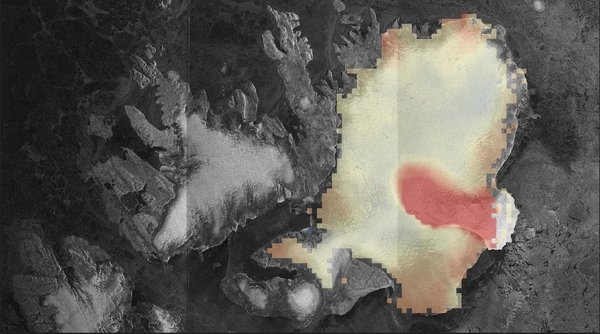According to satellite images, a remote Arctic ice cap has lost more than 50 meters of thickness since 2012, which is about one-sixth of its original thickness. More alarmingly, it is now flowing 25 times faster!
A scientific team from the Centre of Polar Observation and Modelling (CPOM) at the University of Leeds gathered observation data from eight satellite missions, including CryoSat and Sentinel-1A, and combined them with regional climate models, to determine the rate of ice decline.
Their study findings show that over the past 20 years, ice loss from the south-east region of Austfonna, located in the Svalbard archipelago, has accelerated considerably – to speeds of several kilometers (km) annually. Ice thinning has spread more than 50km inland, to within 10km of the sumit.
The Svalbard archipelago is between continental northern Norway and the North Pole.
Lead author and CPOM team member, Dr. Mal McMillan said:
“These results provide a clear example of just how quickly ice caps can evolve, and highlight the challenges associated with making projections of their future contribution to sea level rise.”

The image shows the rate of ice cap elevation change between 2010 and 2014 observed by the CryoSat satellite, which is overlaid onto an image acquired by the Sentinel-1A satellite. Red regions show where the ice surface has lowered due to ice loss. (Credit: CPOM/GRL. Image: Google Drive)
Study findings have been published in the academic journal Geophysical Research Letters (citation below), and have also been reported online today by the European Space Agency (ESA). The authors claim their research is the first to make use of measurements from Sentinal-A1, ESA’s latest Earth observation satellite.
CryoSat has been in orbit for five years, while Sentinel-1A, the first satellite developed for Europe’s Copernicus program, was launch in April 2014.
Dr McMillan said:
“New satellites, such as the Sentinel-1A and CryoSat missions, are essential for enabling us to systematically monitor ice caps and ice sheets, and to better understand these remote polar environments.”
Scientists calculate that approximately one third of recent global sea level rises have been due to melting ice caps and glaciers.
Although nearly all researchers agree that they will continue losing ice in the future, determining at what rate is difficult, due to lack of observations as well as the complex nature of how they interact with the surrounding climate.

Heavily crevassed terminus of Kapp Mohn outlet glacier, Austfonna, in May 2013, after 25-fold increase in flow speed (Dunse et al., The Cryosphere Discussions, 2014.) (Credit: Thorben Dunse, University of Oslo. Image: Google Drive)
CPOM Director, Professor Andrew Shepherd, said:
“Glacier surges, similar to what we have observed, are a well-known phenomenon. However, what we see here is unusual because it has developed over such a long period of time, and appears to have started when ice began to thin and accelerate at the coast.”
Evidence shows that the surrounding ocean temperature has risen in recent years, which may have sparked the ice cap thinning, the authors say.
Professor Shepherd added:
“Whether or not the warmer ocean water and ice cap behaviour are directly linked remains an unanswered question. Feeding the results into existing ice flow models may help us to shed light on the cause, and also improve predictions of global ice loss and sea level rise in the future.”
Satellite observation data are the key to monitoring such climate-related phenomena in the years to come, the researchers say.
Citation: “Rapid dynamic activation of a marine-based Arctic ice cap,” Malcolm McMillan, Andrew Shepherd, Noel Gourmelen, Amaury Dehecq, Amber Leeson, Andrew Ridout, Thomas Flament, Anna Hogg, Lin Gilbert, Toby Benham, Michiel van den Broeke, Julian A. Dowdeswell, Xavier Fettweis, Brice Noël and Tazio Strozzi. Geophysical Research Letters. Article first published online: 23 DEC 2014 DOI: 10.1002/2014GL062255.
